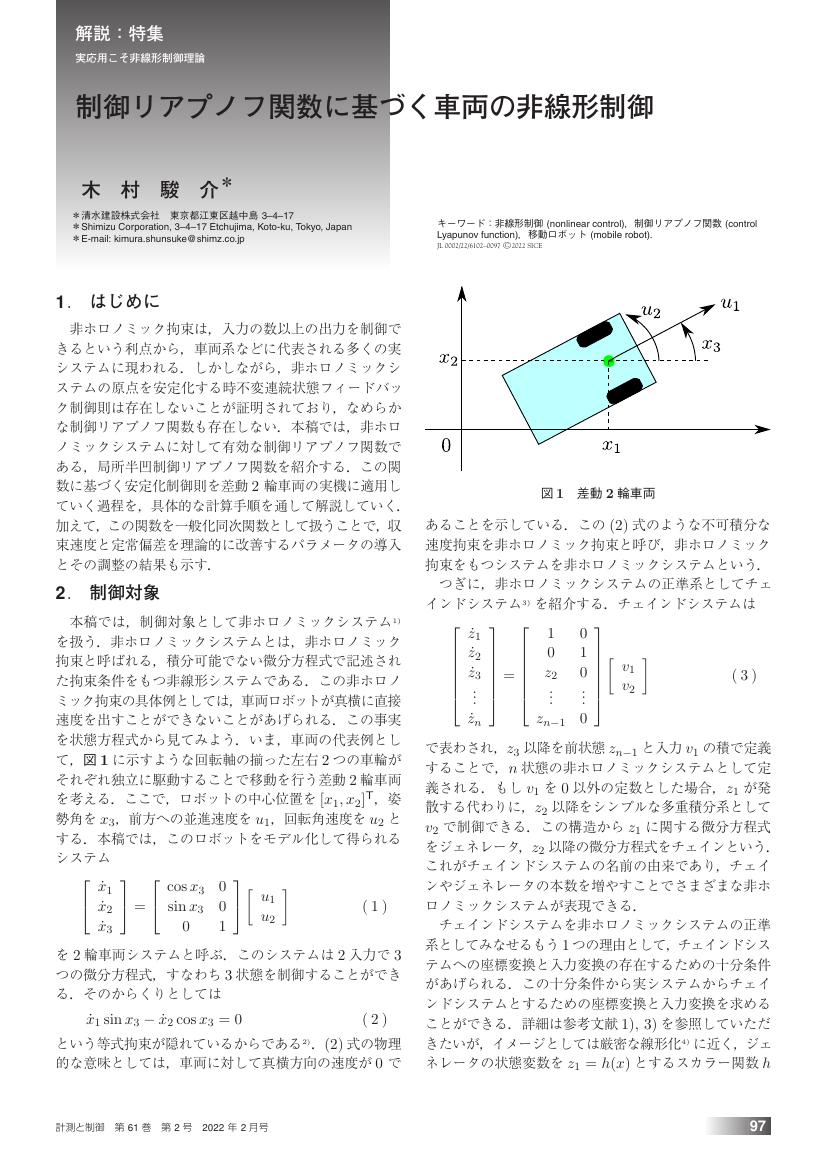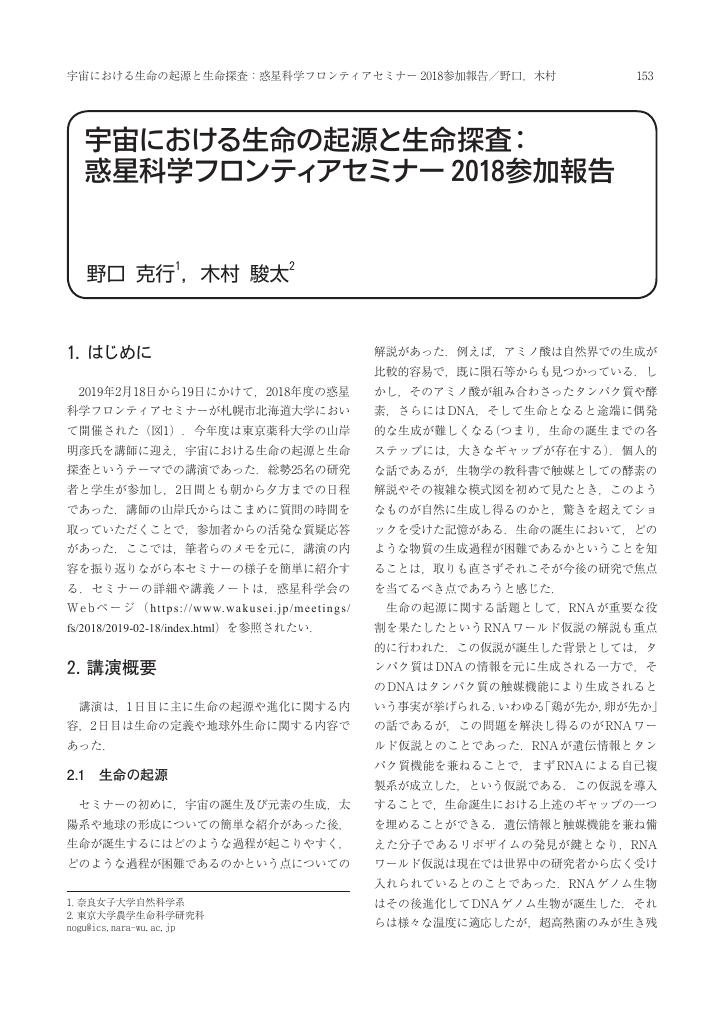25 0 0 0 OA 制御リアプノフ関数に基づく車両の非線形制御
- 著者
- 木村 駿介
- 出版者
- 公益社団法人 計測自動制御学会
- 雑誌
- 計測と制御 (ISSN:04534662)
- 巻号頁・発行日
- vol.61, no.2, pp.97-102, 2022-02-10 (Released:2022-02-11)
- 参考文献数
- 15
- 被引用文献数
- 1
視覚障がい者の自由な移動を可能にするため,白杖やスマートフォンアプリなどさまざまな支援技術が開発されてきた.しかし初めて訪れる公共空間での移動は依然として困難である.そこで行き先を対話的に選択することで目的地まで誘導する,スーツケースを模した自律型ナビゲーションロボットシステム「AIスーツケース」を開発した.本稿では開発のきっかけから複数企業による共同開発に至った経緯を紹介するとともに,AIスーツケース・システムを構成する技術について解説する.各組織が実施している実験から得られつつある最新の知見を紹介するとともに,今後の普及に向けた技術的,制度的,社会的課題について考える.
8 0 0 0 OA 共食の質尺度の作成および精神的健康との関連
- 著者
- 木村 駿介 嘉瀬 貴祥 大石 和男
- 出版者
- 一般社団法人 日本家政学会
- 雑誌
- 日本家政学会誌 (ISSN:09135227)
- 巻号頁・発行日
- vol.69, no.6, pp.439-447, 2018 (Released:2018-06-28)
- 参考文献数
- 32
- 被引用文献数
- 1
The purpose of this study was to develop a Scale for Shared Mealtime Quality (SSMQ), and to investigate the relationships between Shared Mealtime Quality (SMQ) and life stages or mental health, after first defining SMQ. As a result of our preliminary study, SMQ was defined as “sharing enjoyment in the presence of others at mealtime”, and 27 items were collected for the scale. Factor analysis in our main study showed that SSMQ consisted of three factors: “family” (7 items), “friend” (7 items), and “childhood eating habits.” Hierarchical confirmatory factor analysis indicated that SSMQ possessed three factors constructing SMQ, and one general factor of comprehensive SMQ. For the friend and family factors, one-way analysis of variance revealed significant differences in three individual life stages (adulthood, late middle age, and old age). Multiple comparisons revealed that old age showed a higher friend factor score than that of adulthood, a higher family factor score than those of late middle age and adulthood, and late middle age showed a higher family score than that of adulthood. Additionally, correlation analysis indicated that friend and family factors were negatively related to mental health.
4 0 0 0 OA 共食と精神的健康の関連―共食の質的側面に注目して―
- 著者
- 木村 駿介
- 出版者
- RIKKYO UNIVERSITY(立教大学)
- 巻号頁・発行日
- 2020-03-31
3 0 0 0 OA 大学生における身体運動習慣と感覚処理感受性の関連
- 著者
- 矢野 康介 木村 駿介 大石 和男
- 出版者
- 一般社団法人 日本体育学会
- 雑誌
- 体育学研究 (ISSN:04846710)
- 巻号頁・発行日
- vol.62, no.2, pp.587-598, 2017 (Released:2017-12-19)
- 参考文献数
- 37
- 被引用文献数
- 1 2
Previous studies have shown that a high level of sensory-processing sensitivity (SPS) could be a risk factor for mental health. Many studies have reported that daily exercise helps to retain and/or improve mental health. This study examined the relationship between the level of daily exercise and SPS among university students. The participants were 292 university students (143 males and 149 females) ranging in age from 18 to 23 years (19.4±1.1 years). They were asked to complete a questionnaire that included the following items: 1) the frequency of exercise (days per week), 2) the number of years of successive daily exercise, 3) the sporting events in which they currently participate, and 4) the Japanese version of the 19-item Highly Sensitive Person Scale (HSPS-J19) including 3 sub-scales, i.e., low sensory threshold (LST), ease of excitation (EOE), and aesthetic sensitivity (AES). The participants were categorized into a) high, b) medium, and c) low frequency groups, or a) short, b) middle, and c) long term groups individually, based on their levels of participation. Additionally, they were categorized into a) individual, b) team and high-frequency physical contact (HC), and c) team and low-frequency physical contact (LC) exercise groups based on their exercise habits. The high frequency and long-term groups showed lower scores of the HSPS-J19 and its sub-scales of LST, EOE, and AES than the other groups. No significant differences were found among the groups with regard to sports currently played in the scores of the HSPS-J19 and its sub-scales, i.e., LST and EOE. Only AES scores in the LC groups were higher than those in the HC groups. These results suggest that the appearance of SPS was moderated as a result of high-frequency and/or the long-term daily exercise due to habituation to strong stimuli.
- 著者
- 木村 駿介 大石 和男 キムラ シュンスケ オオイシ カズオ Shunsuke Kimura Kazuo Oishi
- 出版者
- 立教大学コミュニティ福祉研究所
- 雑誌
- 立教大学コミュニティ福祉研究所紀要 = Journal of the Institute of Community & Human Services, Rikkyo University (ISSN:24322636)
- 巻号頁・発行日
- no.4, pp.1-16, 2016-11
- 著者
- 木村 駿介 大石 和男 キムラ シュンスケ オオイシ カズオ Shunsuke Kimura Kazuo Oishi
- 出版者
- 立教大学コミュニティ福祉研究所
- 雑誌
- 立教大学コミュニティ福祉研究所紀要 = Journal of the Institute of Community & Human Services, Rikkyo University (ISSN:24322636)
- 巻号頁・発行日
- no.4, pp.17-33, 2016-11
1 0 0 0 OA 宇宙における生命の起源と生命探査: 惑星科学フロンティアセミナー2018参加報告
- 著者
- 野口 克行 木村 駿太
- 出版者
- 日本惑星科学会
- 雑誌
- 日本惑星科学会誌遊星人 (ISSN:0918273X)
- 巻号頁・発行日
- vol.28, no.2, pp.153-156, 2019-06-25 (Released:2020-01-24)
1 0 0 0 県民性と地域性の研究(総合研究・試験研究要約)
- 著者
- 木村 駿
- 出版者
- 日経BP社
- 雑誌
- 日経アーキテクチュア (ISSN:03850870)
- 巻号頁・発行日
- no.889, pp.46-49, 2008-12-08
10月1日未明に大阪市・難波で発生した個室ビデオ店火災。ビルの1階で被害が拡大した背景には何があったのか。2001年の新宿・歌舞伎町の雑居ビル火災、07年の宝塚市のカラオケボックス火災などに続く今回の事件は、雑居ビルや個室型店舗での防災対策に、改めて課題を突き付けている。(木村駿) 買い物を楽しむ若者でにぎわいを見せる大阪市内の商業施設「なんばパークス」。
1 0 0 0 状態制約を有する非線形システムに対する状態方程式を保持する変換
- 著者
- 木村 駿介 中村 文一 伊吹 竜也 三平 満司
- 出版者
- 公益社団法人 計測自動制御学会
- 雑誌
- 計測自動制御学会論文集 (ISSN:04534654)
- 巻号頁・発行日
- vol.53, no.6, pp.337-345, 2017 (Released:2017-06-15)
- 参考文献数
- 17
- 被引用文献数
- 1
Coordinates transformation is a fundamental tool for nonlinear system control. Particularly, the transformation is also applied to state constrained problems. This paper investigates a coordinates and input transformation method, and proposes a new transformation method named “system revival transformation.” The system revival transformation generates a virtual system having the same state equation as an original system. By the proposed transformation, a controller for state constrained systems can be designed by using a controller for unconstrained systems. For general nonlinear systems, the paper provides a mathematical definition of the system revival transformation and proves global asymptotic stability. Moreover, a system revival transformation design method is also presented for control affine nonlinear systems. The effectiveness of the system revival transformation is confirmed through a stabilization problem of a two-wheeled mobile robot.
- 著者
- 木村 駿介 大石 和男 キムラ シュンスケ オオイシ カズオ Shunsuke Kimura Kazuo Oishi
- 雑誌
- 立教大学コミュニティ福祉研究所紀要
- 巻号頁・発行日
- vol.4, pp.1-16, 2016-11
- 著者
- 木村 駿介 大石 和男 キムラ シュンスケ オオイシ カズオ Shunsuke Kimura Kazuo Oishi
- 雑誌
- 立教大学コミュニティ福祉研究所紀要
- 巻号頁・発行日
- vol.4, pp.17-33, 2016-11
1 0 0 0 OA 川村清雄 : 作品と其人物
- 著者
- 木村 駿
- 出版者
- 日経BP社
- 雑誌
- 日経アーキテクチュア (ISSN:03850870)
- 巻号頁・発行日
- no.897, pp.22-27, 2009-04-13
幾重にも連続する開口部を通して、光や中庭の木々だけでなく、同じ建物内のテナントの息遣い、さらにはその先に広がる山並みまでもが、室内に飛び込んでくる。 UID一級建築士事務所代表の前田圭介氏が広島県福山市で手掛けたオフィスビルは、南北の間口が約10m、東西の奥行きが約45mの「うなぎの寝床」のような敷地に建つ。敷地は西側で前面道路に接している。建物は東側に寄せた。

